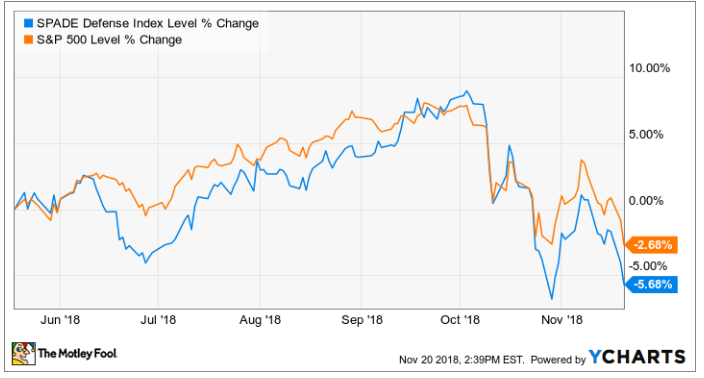Lawmakers Are Urged To Boost Military Spending Or Face Dire Consequences

The military strength of the United States has "eroded to a dangerous degree," creating a "crisis of national security" that can only be rectified with increased Pentagon spending, according to a new report commissioned by Congress. It's a sobering message for the American public, but also one that highlights the opportunities ahead for top military contractors.
This article originally appeared in the Motley Fool.
In a 116-page report, the National Defense Strategy Commission, a bipartisan group put together in July 2017 to assess the military's overall capability, put the blame on various targets. They include lawmakers (who, the commission said, have played politics with funding requests and have favored pet projects over military needs) and the Pentagon itself, for an outdated culture and a lack of spending discipline. And while it offers a range of suggestions on ways the military can improve, the commission makes it clear that Congress needs to be supportive with funding.
The commission's report concludes "unequivocally that the [National Defense Strategy] is not adequately resourced." Although the group said it is "beyond the scope of our work" to pinpoint the exact dollar amount required to fully fund the military's needs, "available resources are clearly insufficient to fulfill the strategy's ambitious goals."
Specifically, the commission concludes that the Department of Defense does not have the resources to defeat a major-power adversary while also simultaneously deterring other enemies. And it said that "available resources are also insufficient to undertake essential nuclear and conventional modernization simultaneously and rectify accumulated readiness shortfalls."
Becoming battle ready
The commission's work is centered around the National Defense Strategy (NDS) document released by the Pentagon back in January, which was designed as a template for how Secretary of Defense James Mattis wants to structure the department. The NDS is pushing the military to shift its focus away from fights against insurgents and small forces in the Middle East, and toward a potential conflict with China or Russia.
The group endorsed the strategy but questioned how the Pentagon intends to reach its goals. The military is going to need different types of equipment and resources for future assignments, and that means new business for contractors.
Depending on what areas the Pentagon prioritizes, there should be opportunities across the board.
General Dynamics (NYSE:GD) and Huntington Ingalls (NYSE:HII), the primary U.S. shipbuilders, would benefit from a push to dramatically increase the size of the Navy. General Dynamics, along with Textron (NYSE:TXT), should do well if the Army follows through on its plan to revamp its land and helicopter capabilities. And Lockheed Martin (NYSE:LMT), Boeing(NYSE:BA), Northrop Grumman (NYSE:NOC), and Raytheon (NYSE:RTN) are all heavily invested in designing new space, aeronautics, and missile capabilities necessary to keep pace with improving Chinese and Russian technologies.
A well-timed warning
For defense contractors, the timing of this report could not have been better. After two years of solid increases thanks to the Bipartisan Budget Act of 2018, the industry has been bracing for a 2020 budget that could be flat at best. With the opposition party now in control of the House of Representatives, a new compromise that would extend those gains will be difficult, raising the possibility of a return to sequestration in 2020 and a drop in Pentagon allocations by as much as $100 billion annually.
Defense shares have underperformed the broader market over the last six months on increased concerns that the White House and Congress will not be able to agree on continued Pentagon funding.

There figures to be no shortage of political drama and rhetoric in the months to come. Inserting a sobering assessment from a bipartisan source could be just what the Pentagon, and the industry, need when lobbying for continued funding.
The report highlights the real-world ramifications of an entrenched budget battle, with the commission concluding that the Pentagon is going to need to increase its base budget at a rate of 3% to 5% above inflation for the foreseeable future just to keep pace with growing threats from China, Russia, and elsewhere.
In the commission's words:
The costs of failing to meet America's crisis of national defense and national security will not be measured in abstract concepts like "international stability" and "global order." They will be measured in American lives, American treasure, and American security and prosperity lost. It will be a tragedy -- of unforeseeable but perhaps tremendous magnitude -- if the United States allows its national interests and national security to be compromised through an unwillingness or inability to make hard choices and necessary investments. That tragedy will be all the more regrettable because it is within our power to avoid it.
Defense stocks figure to languish should the president's February budget release fail to produce a deal by spring or summer, leading to fears of a government shutdown next fall. That's the worst-case scenario, but a realistic one given the makeup of Congress after the midterm elections. The industry and its investors need every weapon available to try to keep that worst case from becoming reality.
Perhaps this report will be the call to arms needed to keep the funds flowing at the Pentagon.
Lou Whiteman has no position in any of the stocks mentioned. The Motley Fool recommends Textron. The Motley Fool has a disclosure policy.




















